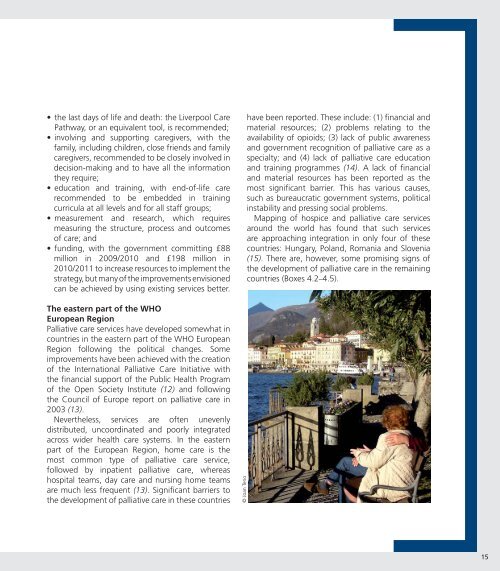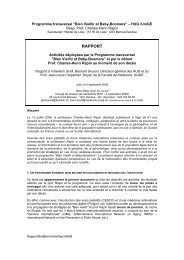Palliative care for older people - World Health Organization ...
Palliative care for older people - World Health Organization ...
Palliative care for older people - World Health Organization ...
Create successful ePaper yourself
Turn your PDF publications into a flip-book with our unique Google optimized e-Paper software.
• the last days of life and death: the Liverpool CarePathway, or an equivalent tool, is recommended;• involving and supporting <strong>care</strong>givers, with thefamily, including children, close friends and family<strong>care</strong>givers, recommended to be closely involved indecision-making and to have all the in<strong>for</strong>mationthey require;• education and training, with end-of-life <strong>care</strong>recommended to be embedded in trainingcurricula at all levels and <strong>for</strong> all staff groups;• measurement and research, which requiresmeasuring the structure, process and outcomesof <strong>care</strong>; and• funding, with the government committing £88million in 2009/2010 and £198 million in2010/2011 to increase resources to implement thestrategy, but many of the improvements envisionedcan be achieved by using existing services better.The eastern part of the WHOEuropean Region<strong>Palliative</strong> <strong>care</strong> services have developed somewhat incountries in the eastern part of the WHO EuropeanRegion following the political changes. Someimprovements have been achieved with the creationof the International <strong>Palliative</strong> Care Initiative withthe financial support of the Public <strong>Health</strong> Programof the Open Society Institute (12) and followingthe Council of Europe report on palliative <strong>care</strong> in2003 (13).Nevertheless, services are often unevenlydistributed, uncoordinated and poorly integratedacross wider health <strong>care</strong> systems. In the easternpart of the European Region, home <strong>care</strong> is themost common type of palliative <strong>care</strong> service,followed by inpatient palliative <strong>care</strong>, whereashospital teams, day <strong>care</strong> and nursing home teamsare much less frequent (13). Significant barriers tothe development of palliative <strong>care</strong> in these countries© Joan Tenohave been reported. These include: (1) financial andmaterial resources; (2) problems relating to theavailability of opioids; (3) lack of public awarenessand government recognition of palliative <strong>care</strong> as aspecialty; and (4) lack of palliative <strong>care</strong> educationand training programmes (14). A lack of financialand material resources has been reported as themost significant barrier. This has various causes,such as bureaucratic government systems, politicalinstability and pressing social problems.Mapping of hospice and palliative <strong>care</strong> servicesaround the world has found that such servicesare approaching integration in only four of thesecountries: Hungary, Poland, Romania and Slovenia(15). There are, however, some promising signs ofthe development of palliative <strong>care</strong> in the remainingcountries (Boxes 4.2–4.5).15
















